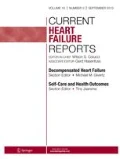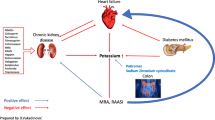Abstract
Multilevel inhibition of neurohormonal activation using angiotensin-converting enzyme inhibitors, β-blockers, angiotensin receptor blockers, and aldosterone antagonists is the cornerstone of modern heart failure treatment. Use of these agents in optimal doses is associated with significant improvements in heart failure-associated morbidity and mortality but also may increase serum potassium. Because potassium excretion already is impaired in many heart failure patients because of advanced age, diabetes, or chronic kidney disease, the risk of life-threatening hyperkalemia during treatment is significant. This review discusses the mechanisms, incidence, predictors, and management of hyperkalemia in heart failure, emphasizing the importance of careful patient selection for medical treatment and regular surveillance of potassium and creatinine.
Similar content being viewed by others
References and Recommended Reading
Hunt SA, Abraham WT, Chin MH, et al.: 2009 focused update incorporated into the ACC/AHA 2005 Guidelines for the Diagnosis and Management of Heart Failure in Adults: a report of the American College of Cardiology Foundation/American Heart Association Task Force on Practice Guidelines: developed in collaboration with the International Society for Heart and Lung Transplantation. Circulation 2009, 119:e391–e479.
Juurlink DN, Mamdani MM, Lee DS, et al.: Rates of hyperkalemia after publication of the Randomized Aldactone Evaluation Study. N Engl J Med 2004, 351:543–551.
Rose BD, Post TW: Clinical physiology of acid-base and electrolyte disorders, edn 5. New York: McGraw-Hill, Medical Publishing Division; 2001.
Sweadner KJ, Goldin SM: Active transport of sodium and potassium ions: mechanism, function, and regulation. N Engl J Med 1980, 302:777–783.
Sterns RH, Cox M, Feig PU, Singer I: Internal potassium balance and the control of the plasma potassium concentration. Medicine 1981, 60:339–354.
Epstein FH, Rosa RM: Adrenergic control of serum potassium. N Engl J Med 1983, 309:1450–1451.
Halperin ML, Kamel KS: Potassium. Lancet 1998, 352:135–140.
Stanton BA: Regulation of Na+ and K+ transport by mineralocorticoids. Sem Nephrol 1987, 7:82–90.
Khuri RN, Strieder WN, Giebisch G: Effects of flow rate and potassium intake on distal tubular potassium transfer. Am J Physiol 1975, 228:1249–1261.
Palmer BF: Managing hyperkalemia caused by inhibitors of the renin-angiotensin-aldosterone system. N Engl J Med 2004, 351:585–592.
Bansal S, Lindenfeld, J, Schrier RW: Sodium retention in heart failure and cirrhosis: potential role of natriuretic doses of mineralocorticoid antagonist? Circ Heart Fail 2009, 2:370–376.
McMurray JJ, O’Meara E: Treatment of heart failure with spironolactone—trial and tribulations. N Engl J Med 2004, 351:526–528.
Rosa RM, Silva P, Young JB, et al.: Adrenergic modulation of extrarenal potassium disposal. N Engl J Med 1980, 302:431–434.
Sica DA, Hess M: Pharmacotherapy in congestive heart failure: aldosterone receptor antagonism: interface with hyperkalemia in heart failure. Congest Heart Fail 2004, 10:259–264.
Desai AS, Swedberg K, McMurray JJ, et al.: Incidence and predictors of hyperkalemia in patients with heart failure: an analysis of the CHARM Program. J Am Coll Cardiol 2007, 50:1959–1966.
Khanna A, White WB: The management of hyperkalemia in patients with cardiovascular disease. Am J Med 2009, 122:215–221.
DeFronzo RA: Hyperkalemia and hyporeninemic hypoaldosteronism. Kidney Int 1980, 17:118–134.
Gonick HC, Kleeman CR, Rubini ME, Maxwell MH: Functional impairment in chronic renal disease. 3. Studies of potassium excretion. Am J Med Sci 1971, 261:281–290.
Einhorn LM, Zhan M, Hsu VD, et al.: The frequency of hyperkalemia and its significance in chronic kidney disease. Arch Intern Med 2009, 169:1156–1162.
Effect of enalapril on survival in patients with reduced left ventricular ejection fractions and congestive heart failure. The SOLVD Investigators. N Engl J Med 1991, 325:293–302.
Effect of enalapril on mortality and the development of heart failure in asymptomatic patients with reduced left ventricular ejection fractions. The SOLVD Investigators. N Engl J Med 1992, 327:685–691.
de Denus S, Tardif JC, White M, et al.: Quantification of the risk and predictors of hyperkalemia in patients with left ventricular dysfunction: a retrospective analysis of the Studies of Left Ventricular Dysfunction (SOLVD) trials. Am Heart J 2006, 152:705–712.
Pfeffer MA, Swedberg K, Granger CB, et al.: Effects of candesartan on mortality and morbidity in patients with chronic heart failure: the CHARM-Overall programme. Lancet 2003, 362:759–766.
Yusuf S, Pfeffer MA, Swedberg K, et al.: Effects of candesartan in patients with chronic heart failure and preserved left-ventricular ejection fraction: the CHARM-Preserved Trial. Lancet 2003, 362:777–781.
McMurray JJ, Ostergren J, Swedberg K, et al.: Effects of candesartan in patients with chronic heart failure and reduced left-ventricular systolic function taking angiotensin-converting-enzyme inhibitors: the CHARM-Added trial. Lancet 2003, 362:767–771.
Pitt B, Remme W, Zannad F, et al.: Eplerenone, a selective aldosterone blocker, in patients with left ventricular dysfunction after myocardial infarction. N Engl J Med 2003, 348:1309–1321.
Pitt B, Bakris G, Ruilope LM, et al.: Serum potassium and clinical outcomes in the Eplerenone Post-Acute Myocardial Infarction Heart Failure Efficacy and Survival Study (EPHESUS). Circulation 2008, 118:1643–1650.
Pitt B, Zannad F, Remme WJ, et al.: The effect of spironolactone on morbidity and mortality in patients with severe heart failure. Randomized Aldactone Evaluation Study Investigators. N Engl J Med 1999, 341:709–717.
Phillips CO, Kashani A, Ko DK, et al.: Adverse effects of combination angiotensin II receptor blockers plus angiotensin-converting enzyme inhibitors for left ventricular dysfunction: a quantitative review of data from randomized clinical trials. Arch Intern Med 2007, 167:1930–1936.
Desai A: Hyperkalemia associated with inhibitors of the renin-angiotensin-aldosterone system: balancing risk and benefit. Circulation 2008, 118:1609–1611.
Hillege HL, Nitsch D, Pfeffer MA, et al.: Renal function as a predictor of outcome in a broad spectrum of patients with heart failure. Circulation 2006, 113:671–678.
Bozkurt B, Agoston I, Knowlton AA: Complications of inappropriate use of spironolactone in heart failure: when an old medicine spirals out of new guidelines. J Am Coll Cardiol 2003, 41:211–214.
Shah KB, Rao K, Sawyer R, Gottlieb SS: The adequacy of laboratory monitoring in patients treated with spironolactone for congestive heart failure. J Am Coll Cardiol 2005, 46:845–849.
Juurlink DN, Hansten PD: Drug safety in patients with heart failure. Arch Internal Med 2005, 165:118.
Massie BM, Carson PE, McMurray JJ, et al.: Irbesartan in patients with heart failure and preserved ejection fraction. The N Engl J Med 2008, 359:2456–2467.
Shlipak MG: Pharmacotherapy for heart failure in patients with renal insufficiency. Ann Intern Med 2003, 138:917–924.
Campbell WB, Gomez-Sanchez CE, Adams BV, et al.: Attenuation of angiotensin II- and III-induced aldosterone release by prostaglandin synthesis inhibitors. J Clin Invest 1979, 64:1552–1557.
Akinbamowo AO, Salzberg DJ, Weir MR: Renal consequences of prostaglandin inhibition in heart failure. Heart Fail Clin 2008, 4:505–510.
Harris RC Jr: Cyclooxygenase-2 inhibition and renal physiology. Am J Cardiol 2002, 89:10D–17D.
Levy Yeyati N, Fellet A, Arranz C, et al.: Amiloridesensitive and amiloride-insensitive kaliuresis in advanced chronic kidney disease. J Nephrol 2008, 21:93–98.
Kleyman TR, Roberts C, Ling BN: A mechanism for pentamidine-induced hyperkalemia: inhibition of distal nephron sodium transport. Ann Intern Med 1995, 122:103–106.
Scoble JE, Varghese Z, Sweny P, Moorhead J: Renal physiology revisited: amiloride. Lancet 1986, 2:326–328.
Perazella MA: Trimethoprim-induced hyperkalaemia: clinical data, mechanism, prevention and management. Drug Saf 2000, 22:227–236.
Taylor DO, Barr ML, Radovancevic B, et al.: A randomized, multicenter comparison of tacrolimus and cyclosporine immunosuppressive regimens in cardiac transplantation: decreased hyperlipidemia and hypertension with tacrolimus. J Heart Lung Transplant 1999, 18:336–345.
Stigant CE, Cohen J, Vivera M, Zaltzman JS: ACE inhibitors and angiotensin II antagonists in renal transplantation: an analysis of safety and efficacy. Am J Kidney Dis 2000, 35:58–63.
Oster JR, Singer I, Fishman LM: Heparin-induced aldosterone suppression and hyperkalemia. Am J Med 1995, 98:575–586.
Bay WH, Hartman JA: High potassium in low-sodium soups. N Engl J Med 1983, 308:1166–1167.
Restuccio A: Fatal hyperkalemia from a salt substitute. Am J Emerg Med 1992, 10:171–173.
Ray K, Dorman S, Watson R: Severe hyperkalaemia due to the concomitant use of salt substitutes and ACE inhibitors in hypertension: a potentially life threatening interaction. J Hum Hypertens 1999, 13:717–720.
Dardik A, Moesinger RC, Efron G, et al.: Acute abdomen with colonic necrosis induced by Kayexalate-sorbitol. South Med J 2000, 93:511–513.
Author information
Authors and Affiliations
Corresponding author
Rights and permissions
About this article
Cite this article
Desai, A.S. Hyperkalemia in patients with heart failure: Incidence, prevalence, and management. Curr Heart Fail Rep 6, 272–280 (2009). https://doi.org/10.1007/s11897-009-0037-1
Published:
Issue Date:
DOI: https://doi.org/10.1007/s11897-009-0037-1




